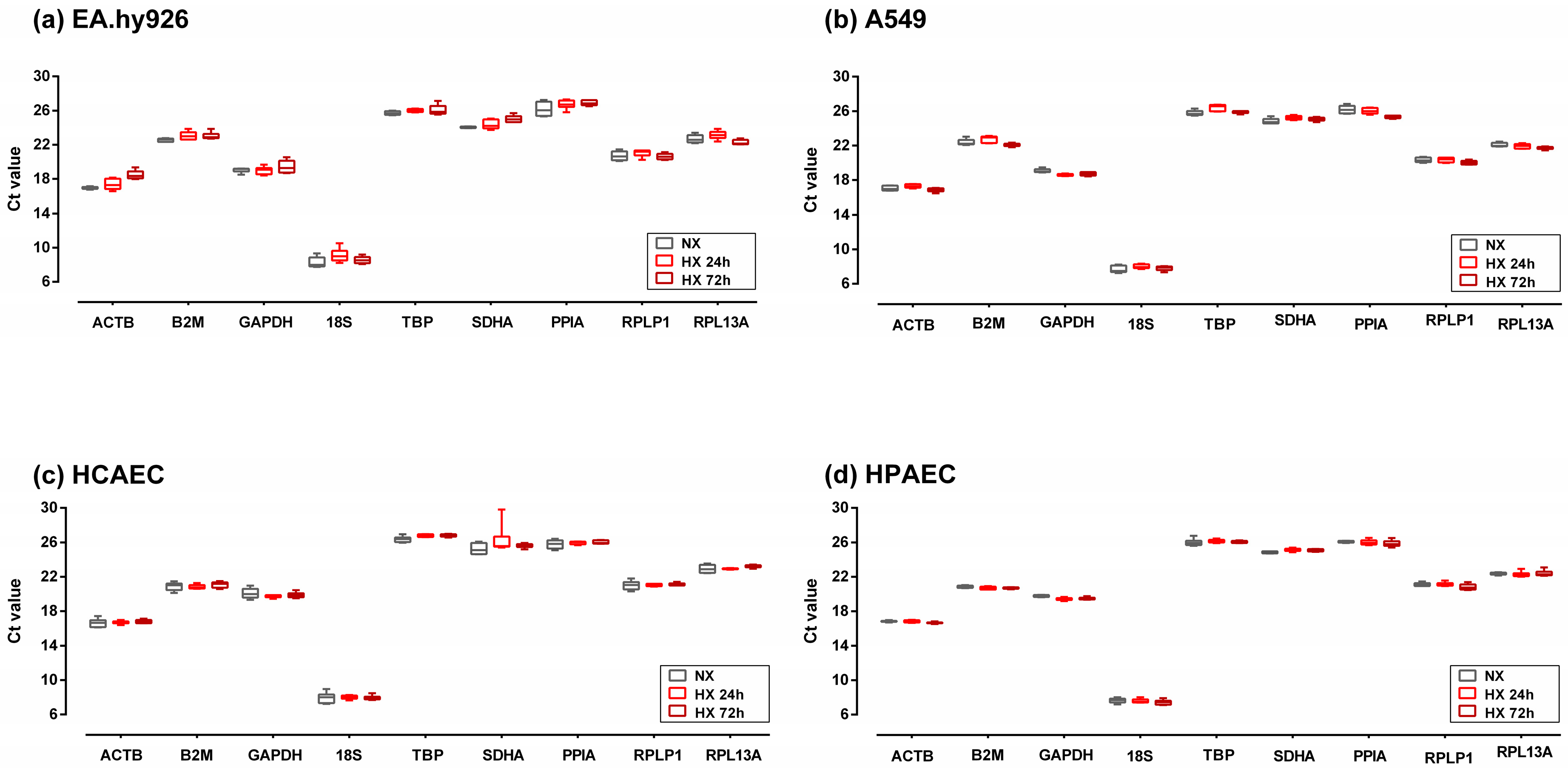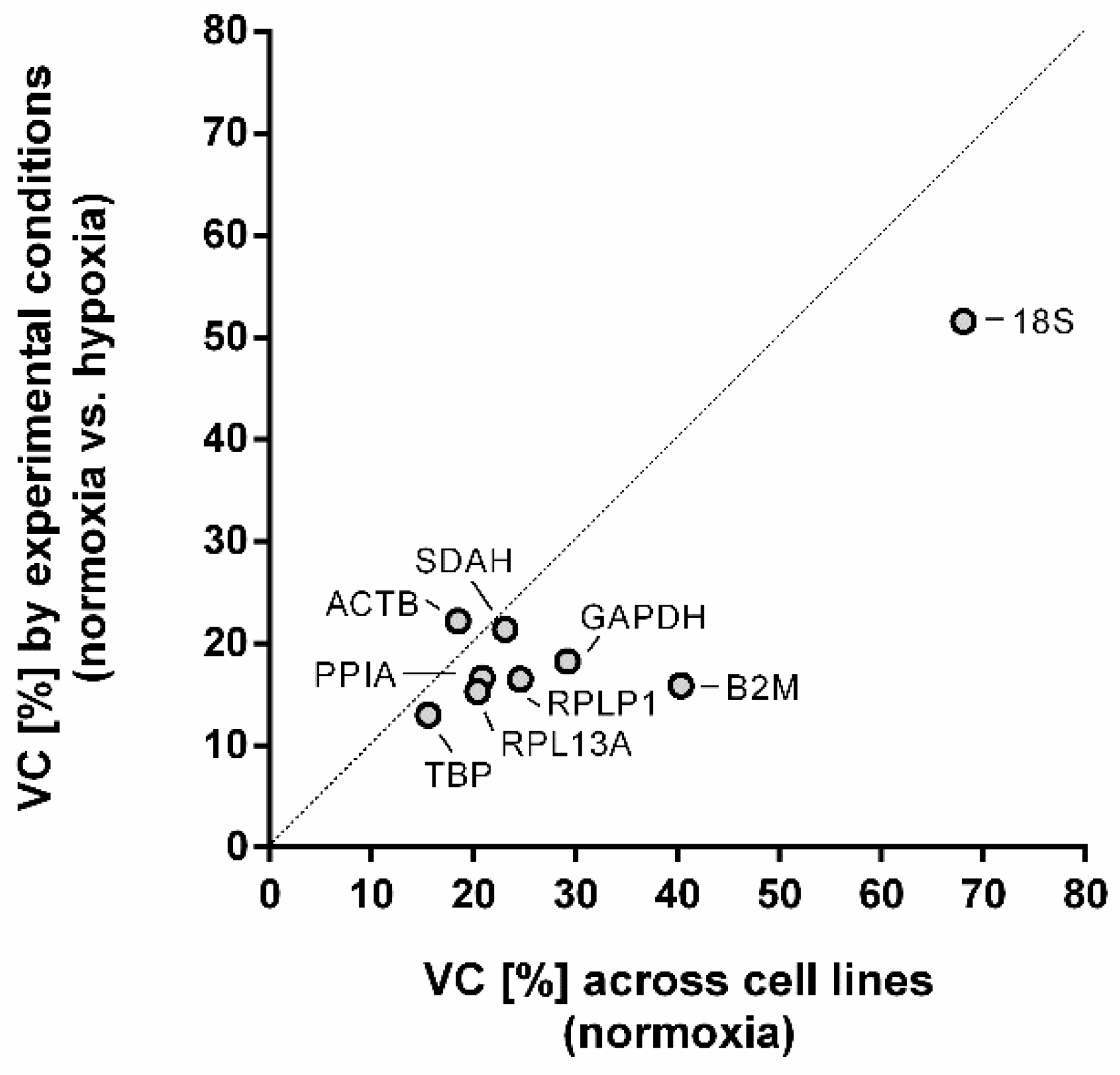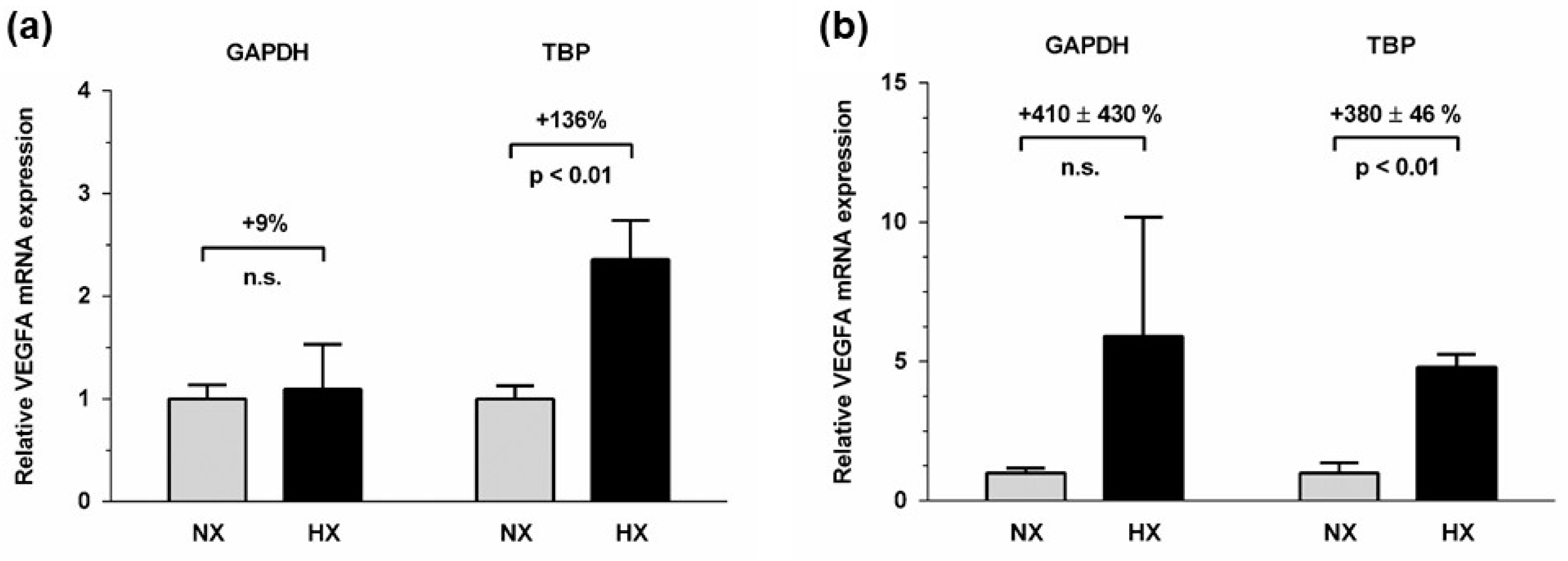Selection of Reference Genes for Normalization of Gene Expression After Exposure of Human Endothelial and Epithelial Cells to Hypoxia
Abstract
1. Introduction
2. Results
2.1. Expression Profiles of Putative Reference Genes in Normoxia and Hypoxia
2.2. Expression Stability of Putative Reference Genes in Normoxia and Hypoxia in Each Cell Line
2.3. Finding the Optimal Reference Gene Across All Four Cell Lines
2.4. Identification of the Most Stably Expressed Reference Gene in Combinations of Two Cell Lines
2.5. Effects of Reference Gene Selection on the Analysis of VEGFA Gene Expression in Hypoxia
3. Discussion
4. Materials and Methods
4.1. Cell Culture
4.2. Experimental Conditions (Hypoxia Versus Normoxia)
4.3. RNA Isolation and Reverse Transcription
4.4. Quantitative Real-Time PCR
4.5. Calculation of Gene Expression Stability in Hypoxia and Normoxia and Statistical Analysis
5. Conclusions
Supplementary Materials
Author Contributions
Funding
Institutional Review Board Statement
Informed Consent Statement
Data Availability Statement
Conflicts of Interest
References
- Saiki, R.K.; Gelfand, D.H.; Stoffel, S.; Scharf, S.J.; Higuchi, R.; Horn, G.T.; Mullis, K.B.; Erlich, H.A. Primer-directed enzymatic amplification of DNA with a thermostable DNA polymerase. Science 1988, 239, 487–491. [Google Scholar] [CrossRef] [PubMed]
- Dheda, K.; Huggett, J.F.; Chang, J.S.; Kim, L.U.; Bustin, S.A.; Johnson, M.A.; Rook, G.A.; Zumla, A. The implications of using an inappropriate reference gene for real-time reverse transcription PCR data normalization. Anal. Biochem. 2005, 344, 141–143. [Google Scholar] [CrossRef] [PubMed]
- Eisenberg, E.; Levanon, E.Y. Human housekeeping genes, revisited. Trends Genet. 2013, 29, 569–574. [Google Scholar] [CrossRef] [PubMed]
- Dheda, K.; Huggett, J.F.; Bustin, S.A.; Johnson, M.A.; Rook, G.; Zumla, A. Validation of housekeeping genes for normalizing RNA expression in real-time PCR. Biotechniques 2004, 37, 112–119. [Google Scholar] [CrossRef]
- Schmittgen, T.D.; Zakrajsek, B.A. Effect of experimental treatment on housekeeping gene expression: Validation by real-time, quantitative RT-PCR. J. Biochem. Biophys. Methods 2000, 46, 69–81. [Google Scholar] [CrossRef] [PubMed]
- Klenke, S.; Renckhoff, K.; Engler, A.; Peters, J.; Frey, U.H. Easy-to-use strategy for reference gene selection in quantitative real-time PCR experiments. Naunyn Schmiedebergs. Arch. Pharmacol. 2016, 389, 1353–1366. [Google Scholar] [CrossRef] [PubMed]
- Xie, J.; Liu, X.; Li, Y.; Liu, Y.; Su, G. Validation of RT-qPCR reference genes and determination of Robo4 expression levels in human retinal endothelial cells under hypoxia and/or hyperglycemia. Gene 2016, 585, 135–142. [Google Scholar] [CrossRef]
- Lima, L.; Gaiteiro, C.; Peixoto, A.; Soares, J.; Neves, M.; Santos, L.L.; Ferreira, J.A. Reference genes for addressing gene expression of bladder cancer cell models under hypoxia: A step towards transcriptomic studies. PLoS ONE 2016, 11, e0166120. [Google Scholar] [CrossRef] [PubMed]
- Escoubet, B.; Planès, C.; Clerici, C. Hypoxia increases glyceraldehyde-3-phosphate dehydrogenase transcription in rat alveolar epithelial cells. Biochem. Biophys. Res. Commun. 1999, 266, 156–161. [Google Scholar] [CrossRef] [PubMed]
- Graven, K.K.; Bellur, D.; Klahn, B.D.; Lowrey, S.L.; Amberger, E. HIF-2alpha regulates glyceraldehyde-3-phosphate dehydrogenase expression in endothelial cells. Biochim. Biophys. Acta 2003, 1626, 10–18. [Google Scholar] [CrossRef]
- Caradec, J.; Sirab, N.; Keumeugni, C.; Moutereau, S.; Chimingqi, M.; Matar, C.; Revaud, D.; Bah, M.; Manivet, P.; Conti, M.; et al. ’Desperate house genes’: The dramatic example of hypoxia. Br. J. Cancer 2010, 102, 1037–1043. [Google Scholar] [CrossRef] [PubMed]
- Cicinnati, V.R.; Shen, Q.; Sotiropoulos, G.C.; Radtke, A.; Gerken, G.; Beckebaum, S. Validation of putative reference genes for gene expression studies in human hepatocellular carcinoma using real-time quantitative RT-PCR. BMC Cancer 2008, 8, 350. [Google Scholar] [CrossRef]
- Fjeldbo, C.S.; Aarnes, E.K.; Malinen, E.; Kristensen, G.B.; Lyng, H. Identification and validation of reference genes for RT-qPCR studies of hypoxia in squamous cervical cancer patients. PLoS ONE 2016, 11, e0156259. [Google Scholar] [CrossRef] [PubMed]
- Lossos, I.S.; Czerwinski, D.K.; Wechser, M.A.; Levy, R. Optimization of quantitative real-time RT-PCR parameters for the study of lymphoid malignancies. Leukemia 2003, 17, 789–795. [Google Scholar] [CrossRef]
- Yan, W.; Xie, M.; Li, R.; Hu, H.; Tang, B.; Shen, J. Identification and validation of reference genes selection in ovarian cancer exposed to hypoxia. Onco Targets Ther. 2020, 13, 7423–7431. [Google Scholar] [CrossRef] [PubMed]
- Böger, R.; Hannemann, J. Dual role of the L-arginine-ADMA-NO pathway in systemic hypoxic vasodilation and pulmonary hypoxic vasoconstriction. Pulm. Circ. 2020, 10, 2045894020918850. [Google Scholar] [CrossRef] [PubMed]
- Silver, N.; Best, S.; Jiang, J.; Thein, S.L. Selection of housekeeping genes for gene expression studies in human reticulocytes using real-time PCR. BMC Mol. Biol. 2006, 7, 33. [Google Scholar] [CrossRef]
- Chapman, J.R.; Waldenström, J. With Reference to Reference Genes: A Systematic Review of Endogenous Controls in Gene Expression Studies. PLoS ONE 2015, 10, e0141853. [Google Scholar] [CrossRef] [PubMed]
- Suzuki, T.; Higgins, P.J.; Crawford, D.R. Control selection for RNA quantitation. Biotechniques 2000, 29, 332–337. [Google Scholar] [CrossRef] [PubMed]
- Ruan, W.; Lai, M. Actin, a reliable marker of internal control? Clin. Chim. Acta 2007, 385, 1–5. [Google Scholar] [CrossRef]
- Zhong, H.; Simons, J.W. Direct comparison of GAPDH, beta-actin, cyclophilin, and 28S rRNA as internal standards for quantifying RNA levels under hypoxia. Biochem. Biophys. Res. Commun. 1999, 259, 523–526. [Google Scholar] [CrossRef]
- Vandesompele, J.; De Preter, K.; Pattyn, F.; Poppe, B.; Van Roy, N.; De Paepe, A.; Speleman, F. Accurate normalization of real-time quantitative RT-PCR data by geometric averaging of multiple internal control genes. Genome Biol. 2002, 3, research0034. [Google Scholar] [CrossRef]
- Hruz, T.; Wyss, M.; Docquier, M.; Pfaffl, M.W.; Masanetz, S.; Borghi, L.; Verbrugghe, P.; Kalaydjieva, L.; Bleuler, S.; Laule, O.; et al. RefGenes: Identification of reliable and condition specific reference genes for RT-qPCR data normalization. BMC Genom. 2011, 12, 156. [Google Scholar] [CrossRef]
- Van Acker, S.I.; Van Acker, Z.P.; Haagdorens, M.; Pintelon, I.; Koppen, C.; Zakaria, N. Selecting appropriate reference genes for quantitative real-time polymerase chain reaction studies in isolated and cultured ocular surface epithelia. Sci. Rep. 2019, 9, 19631. [Google Scholar] [CrossRef]
- Foldager, C.B.; Munir, S.; Ulrik-Vinther, M.; Søballe, K.; Bünger, C.; Lind, M. Validation of suitable house keeping genes for hypoxia-cultured human chondrocytes. BMC Mol. Biol. 2009, 10, 94. [Google Scholar] [CrossRef] [PubMed]
- Curis, E.; Nepost, C.; Grillault Laroche, D.; Courtin, C.; Laplanche, J.L.; Etain, B.; Marie-Claire, C. Selecting reference genes in RT-qPCR based on equivalence tests: A network based approach. Sci. Rep. 2019, 9, 16231. [Google Scholar] [CrossRef] [PubMed]
- Bakhashab, S.; Lary, S.; Ahmed, F.; Schulten, H.J.; Bashir, A.; Ahmed, F.W.; Al-Malki, A.L.; Jamal, H.S.; Gari, M.A.; Weaver, J.U. Reference genes for expression studies in hypoxia and hyperglycemia models in human umbilical vein endothelial cells. G3 Genes Genomes Genet. 2014, 4, 2159–2165. [Google Scholar] [CrossRef] [PubMed]
- Seidler, N.W. GAPDH and intermediary metabolism. Adv. Exp. Med. Biol. 2013, 985, 37–59. [Google Scholar] [PubMed]
- Forsythe, J.A.; Jiang, B.H.; Iyer, N.V.; Agani, F.; Leung, S.W.; Koos, R.D.; Semenza, G.L. Activation of vascular endothelial growth factor gene transcription by hypoxia-inducible factor 1. Mol. Cell. Biol. 1996, 16, 4604–4613. [Google Scholar] [CrossRef]
- Andersen, C.L.; Jensen, J.L.; Ørntoft, T.F. Normalization of real-time quantitative reverse transcription-PCR data: A model-based variance estimation approach to identify genes suited for normalization, applied to bladder and colon cancer data sets. Cancer Res. 2004, 64, 5245–5250. [Google Scholar] [CrossRef] [PubMed]
- Schmittgen, T.D.; Livak, K.J. Analyzing real-time PCR data by the comparative C(T) method. Nat. Protoc. 2008, 3, 1101–1108. [Google Scholar] [CrossRef]




| EA.hy926 | A549 | HCAECs | HPAECs | All Cell Lines | |||||
|---|---|---|---|---|---|---|---|---|---|
| Gene/Ct CV [%] | Gene/Ct CV [%] | Gene/Ct CV [%] | Gene/Ct CV [%] | Gene/Ct CV [%] | |||||
| TBP | 1.48 | RPL13A | 1.14 | TBP | 1.13 | SDHA | 0.71 | PPIA | 1.39 |
| B2M | 1.86 | SDHA | 1.20 | PPIA | 1.19 | ACTB | 0.77 | TBP | 1.62 |
| RPLP1 | 2.21 | RPLP1 | 1.41 | RPL13A | 1.27 | B2M | 0.81 | ACTB | 1.72 |
| SDHA | 2.21 | GAPDH | 1.42 | RPLP1 | 1.43 | TBP | 0.99 | RPLP1 | 2.27 |
| RPL13A | 2.33 | TBP | 1.46 | B2M | 1.70 | GAPDH | 1.03 | RPL13A | 2.33 |
| PPIA | 2.38 | ACTB | 1.64 | ACTB | 1.81 | PPIA | 1.05 | GAPDH | 2.78 |
| GAPDH | 2.66 | B2M | 1.79 | GAPDH | 1.98 | RPL13A | 1.20 | SDHA | 2.93 |
| ACTB | 4.41 | PPIA | 1.85 | SDHA | 4.19 | RPLP1 | 1.37 | B2M | 3.55 |
| 18S | 7.77 | 18S | 4.05 | 18S | 4.73 | 18S | 3.46 | 18S | 4.72 |
| Rank | EA.hy926 | A549 | HCAECs | HPAECs | All Cell Lines | |||||
|---|---|---|---|---|---|---|---|---|---|---|
| Gene/Mean SD | Gene/Mean SD | Gene/Mean SD | Gene/Mean SD | Gene/Mean SD | ||||||
| 1 | B2M | 0.471 | RPL13A | 0.265 | TBP | 0.305 | PPIA | 0.196 | PPIA | 0.590 |
| 2 | TBP | 0.530 | ACTB | 0.276 | RPLP1 | 0.310 | B2M | 0.209 | TBP | 0.604 |
| 3 | RPLP1 | 0.555 | B2M | 0.285 | PPIA | 0.341 | 18S | 0.218 | RPLP1 | 0.615 |
| 4 | SDHA | 0.572 | TBP | 0.290 | RPL13A | 0.347 | ACTB | 0.218 | RPL13A | 0.632 |
| 5 | RPL13A | 0.587 | RPLP1 | 0.290 | ACTB | 0.352 | RPLP1 | 0.226 | 18S | 0.679 |
| 6 | PPIA | 0.615 | 18S | 0.298 | 18S | 0.368 | GAPDH | 0.226 | ACTB | 0.742 |
| 7 | 18S | 0.649 | SDHA | 0.306 | B2M | 0.375 | TBP | 0.239 | GAPDH | 0.752 |
| 8 | GAPDH | 0.711 | PPIA | 0.348 | GAPDH | 0.460 | RPL13A | 0.340 | SDHA | 0.913 |
| 9 | ACTB | 0.764 | GAPDH | 0.379 | SDHA | 0.976 | SDHA | 0.372 | B2M | 1.003 |
| EA.hy926 | A549 | HCAECs | HPAECs | All Cell Lines | |||||
|---|---|---|---|---|---|---|---|---|---|
| Gene | Score | Gene | Score | Gene | Score | Gene | Score | Gene | Score |
| B2M | 4 | RPL13A | 4 | PPIA | 7 | PPIA | 8 | TBP | 8 |
| TBP | 5 | ACTB | 9 | RPLP1 | 7 | ACTB | 9 | PPIA | 9 |
| RPLP1 | 11 | RPLP1 | 11 | TBP | 8 | B2M | 9 | RPLP1 | 9 |
| SDHA | 11 | B2M | 14 | RPL13A | 11 | 18S | 14 | RPL13A | 12 |
| PPIA | 15 | SDHA | 15 | ACTB | 14 | GAPDH | 17 | 18S | 16 |
| RPL13A | 18 | TBP | 16 | B2M | 19 | SDHA | 19 | B2M | 18 |
| GAPDH | 19 | 18S | 20 | 18S | 20 | TBP | 19 | ACTB | 20 |
| 18S | 23 | GAPDH | 22 | GAPDH | 23 | RPL13A | 20 | GAPDH | 20 |
| ACTB | 26 | PPIA | 24 | SDHA | 26 | RPLP1 | 20 | SDHA | 23 |
| HCAECs vs. EA.hy926 | HCAECs vs. HPAECs | HPAECs vs. A549 | |||
|---|---|---|---|---|---|
| Gene | Score | Gene | Score | Gene | Score |
| RPLP1 | 4 | B2M | 6 | TBP | 9 |
| TBP | 8 | RPLP1 | 6 | PPIA | 10 |
| RPL13A | 11 | PPIA | 11 | RPL13A | 10 |
| PPIA | 12 | TBP | 11 | ACTB | 11 |
| 18S | 18 | ACTB | 17 | SDHA | 14 |
| B2M | 18 | 18S | 18 | 18S | 15 |
| GAPDH | 18 | GAPDH | 20 | B2M | 21 |
| ACTB | 22 | RPL13A | 20 | GAPDH | 22 |
| SDHA | 24 | SDHA | 26 | RPLP1 | 23 |
Disclaimer/Publisher’s Note: The statements, opinions and data contained in all publications are solely those of the individual author(s) and contributor(s) and not of MDPI and/or the editor(s). MDPI and/or the editor(s) disclaim responsibility for any injury to people or property resulting from any ideas, methods, instructions or products referred to in the content. |
© 2025 by the authors. Licensee MDPI, Basel, Switzerland. This article is an open access article distributed under the terms and conditions of the Creative Commons Attribution (CC BY) license (https://creativecommons.org/licenses/by/4.0/).
Share and Cite
Hannemann, J.; Schmidt-Hutten, L.; Hannemann, J.; Kleinsang, F.; Böger, R. Selection of Reference Genes for Normalization of Gene Expression After Exposure of Human Endothelial and Epithelial Cells to Hypoxia. Int. J. Mol. Sci. 2025, 26, 1763. https://doi.org/10.3390/ijms26041763
Hannemann J, Schmidt-Hutten L, Hannemann J, Kleinsang F, Böger R. Selection of Reference Genes for Normalization of Gene Expression After Exposure of Human Endothelial and Epithelial Cells to Hypoxia. International Journal of Molecular Sciences. 2025; 26(4):1763. https://doi.org/10.3390/ijms26041763
Chicago/Turabian StyleHannemann, Juliane, Lena Schmidt-Hutten, Jannik Hannemann, Fiona Kleinsang, and Rainer Böger. 2025. "Selection of Reference Genes for Normalization of Gene Expression After Exposure of Human Endothelial and Epithelial Cells to Hypoxia" International Journal of Molecular Sciences 26, no. 4: 1763. https://doi.org/10.3390/ijms26041763
APA StyleHannemann, J., Schmidt-Hutten, L., Hannemann, J., Kleinsang, F., & Böger, R. (2025). Selection of Reference Genes for Normalization of Gene Expression After Exposure of Human Endothelial and Epithelial Cells to Hypoxia. International Journal of Molecular Sciences, 26(4), 1763. https://doi.org/10.3390/ijms26041763







